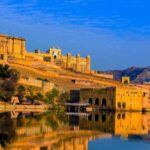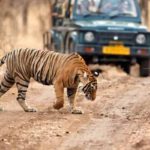Best time to visit Ranthambore From 1 October to 30 June each year, the Ranthambore National Park remains open to tourists according to safari timing. The park is also closed to tourists from July to September due to the rainy season. The best time to visit Ranthambore is from November to April, if the weather is mild and you see the animals without any discomfort due to the weather. There are two safaris a day from October through June, one starting in the morning and one late in the afternoon.
Generally speaking, half an hour after sunrise, the morning safari begins and half an hour before sunset, the evening safari ends. As a consequence, the plans shift slightly every 2 months or so. The length of each safari is from three to three and a half hours. In Ranthambore, summer temperatures can exceed 45 degrees C in the daytime. Winter temperatures during the night will go down to 2 degrees C. Daytime temperatures in winter are a comfortable 16-20 degrees and are great for visiting the Ranthambore National Park.
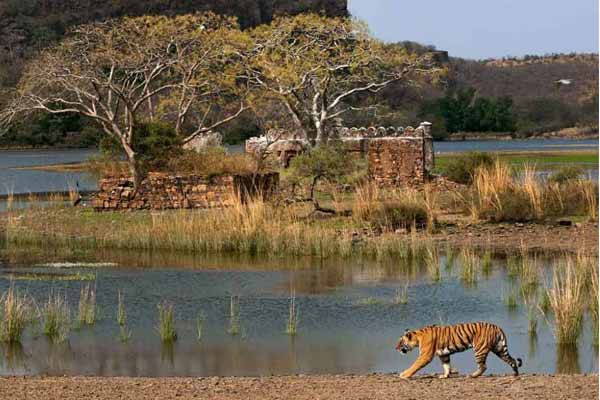
After the monsoon, the park is green and biodiversity is plentiful. Many migratory birds that come to Ranthambore to spend the winter can also be seen. The wind chill factor will not be a bother, either in the early morning or late evening, if you wear appropriate protective clothing. Summer can be a very fruitful time to visit Ranthambore National Park, if the summer heat is not unbearable for you. In the leaf-denuded woods and along the lakes and watering holes, the animals can be clearly seen as they are pushed to the water’s edge by hunger Best Time to Visit Ranthambore.
Best Time to Visit Ranthambore National Park
The Ranthambore National Park is open to tourists from 1 October to 30 June each year for a safari tour according to the entry timing of the specific season. The park is closed to visitors for the remaining months of the year due to the monsoon season. While one can enjoy the safari and enjoy the view of the majestic tiger at any time between the permitted months, it is considered the best time to visit Ranthambore tiger reserve from November to April As the weather around this time is good and nature is enhancing the beauty of the forest in its full bloom around this time.
Summer Season (March – June)
In March, summer begins and ends in June. This is the year’s hottest season. The temperature can reach as high as 45 degrees Celsius. During this season, dehydration is normal. However, for wildlife events, this is the perfect time to visit the park. Due to immense heat, the grasses in the area would have dried. This gives a nice view throughout the safari.
Because of evaporation, the water holes deep in the park will dry up. The animals are therefore required to visit the key sources of water in the park to quench their thirst. This raises the likelihood of endangered animals, including tigers, being spotted. Moreover, it’s unusual to spot other visitors during the summer season. This privacy allows animals to freely walk around and you do not need to wait in line for your turn on the safari.
Monsoon Season (July – September)
In July, the rain begins and ends in September. During this season, the location will be lush and breathtaking. The area, however, experiences heavy rainfall, making it difficult for travel and sightseeing. During this season, the area will also be extremely humid. The national park can be very mushy, causing safaris during the rain to be shortened or prohibited. You won’t be able to see birds or animals during the storm.
Winter Season (October – March)
In October, winter begins and ends in March. It’s a cool and convenient place to fly. Many of the city’s sightseeing spots will be of prime beauty. In Ranthambore National Park, you can find animals with their infants. It is the perfect time to visit for bird spotting. During this season, migratory birds from other countries can flourish in the park. The start of the festival season also signals the winter season. Dusshera is an important festival that is celebrated in Rajasthan, and in October it falls.
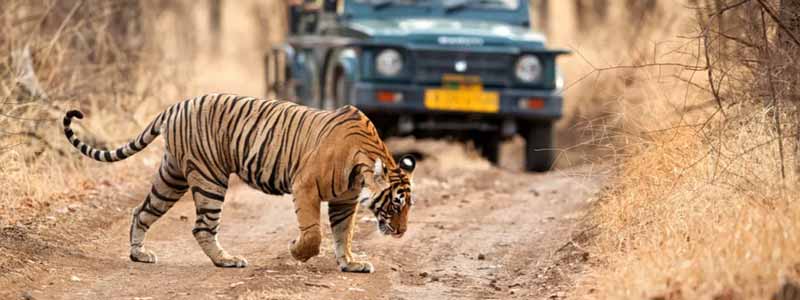
Best Places to Visit in Ranthambore National Park
Among wildlife lovers, Ranthambore National Park, which is located in the Sawai Madhopur district of Rajasthan, is very popular. A tiger reserve area, this national park offers a jungle safari to explore the forest’s flora and fauna, which attracts a large number of wildlife enthusiasts. The thrill of making a rendezvous with the Jungle Lord, the magnificent tiger, is so strong that most people came here to track the tiger solely for the safari. There are, however, a few other sights that you shouldn’t overlook while you’re in Ranthambore. The few places in and around Ranthambore are below, where you can make a visit more memorable for your journey.
Ranthambore Jungle Safari
The Ranthambore Tiger Safari is among the best locations to experience a wildlife safari in India. While the prime attraction here is tiger spotting, jackal, fox, leopard, and mongoose can also be seen. You will observe the Nilgai, Blue Bull Antelope, Chital and Sambar Deer embarking on a jungle safari to this tiger reserve. The flora, apart from the fauna, is also worth admiring here. Rolling hills and crags, lakes and rivulets characterise the landscape. The best forest tours in India to visit the Tigers are provided by Ranthambore.
Jungle Safari is a major attraction at a distance of 8 km from Sawai Madhopur and one of the most popular choices to spot animal activity and admire the beautiful scenery in the Ranthambhore Tiger Reserve. Ranthambore National Park is one of the best places to go on a safari to discover various kinds of wildlife.
Note:- Safari Timings: Safari Timings: 6.30 AM – 9.30 AM & 3.30 PM – 6.30 PM in summer, 7 AM – 10.30 PM & 2.30 PM – 6 PM in winter
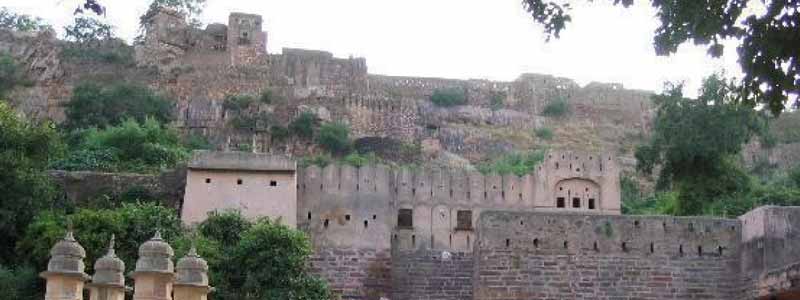
Ranthambore Fort
In the Ranthambore National Park, near the town of Sawai Madhopur, Ranthambore Fort is the park, the former hunting grounds of the Maharajahs of Jaipur before the Independence of India. Having been a focal point of the historical advances of Rajasthan, it is a formidable fort.
An enormous number of attacks and conquests have been seen by the mighty strong fort of Ranthambore. Because of the difficulties they faced in capturing and the well-planned building of the fort, the fort was the main obstacle for the invaders. Within the Ranthambore National Park, which was the hunting grounds for the Jaipur dynasty Maharajas, the Ranthambore Fort is located. It is situated in the Jaipur town of Sawai Madhopur.
Padam Talao & Jogi Mahal
The Padam Talao is a wide and beautiful lake situated within Ranthambore National Park at a distance of 500 m from Ranthambore Fort, and 5 km from Ranthambore National Park Entry Gate. It gets its name from the blooming lotus flowers in the pool. A favourite watering hole of the Ranthambore animals is the Padam Talao. In the early morning and late evening, lions, leopards, deer, monkeys, and peacocks can be seen drinking on the lake’s shore.
An excellent place from where tourists can see the animals in their natural environment is the Machans or huts on observation posts near the Padam Talao. Genghis, one of Ranthambore’s legendary tigers, was famous for hunting deer that came to drink on the lakeside.
On the banks of Padam Talao, the hunting lodge named Jogi Mahal is located. A magnificent one is the view from the Jogi Mahal. Established by the royal families of Jaipur, Jogi Mahal served as a hunting residence for different generations of Jaipur Maharajas. This Mahal is converted into a guest house after the decline of the ruling authorities of Jaipur that offers tourists a comfortable stay during their Best Time to Visit Ranthambore.
Rajiv Gandhi Regional Museum Of Natural History
The Rajiv Gandhi Regional Museum of Natural History is a museum located in the Ramsinghpura village of Sawai Madhopur in Rajasthan, 3.5 km away from Ranthambore National Park and 6.5 km away from Sawai Madhopur Railway Station. After Mysore, Bhopal, and Bhubaneswar, it is the fourth Natural History Regional Museum in India.
In December 2007, the honourable Vice President of India, Hamid Ansari, created the Rajiv Gandhi Regional Museum of Natural History and opened it in 2014. The museum was organised by the Government of India’s Ministry of the Environment and Forests. The museum, spread over 7.2 acres of land, is tastefully built and intends to raise awareness of the diversity of life on earth.
The museum consists of three floors with exhibits on plants, animals, mineral resources and geology from the western region of India and the western dry area. As if now, with a well-placed exhibition on the wildlife in Ranthambore and the famous Ranthambore Fort, only the ground floor is operational. A facsimile of animals such as chinkara, leopard, lion, and tiger are the major tourist attractions.
Kachida Valley Ranthambore
Kachida Valley is located in the outer region of Ranthambore National Park in Rajasthan at a distance of 13 km from Ranthambore National Park. It’s one of the park’s famous jeep safari zones.
Kachida Valley, surrounded by low jagged hills and dotted with revitalising greenery, is one of Ranthambore‘s picturesque and must-visit areas. It is blessed with a wide variety of forms of flora and fauna. This region comprises the bulk of the park’s Panther population. To prevent encounters with tigers, who are known to kill them, the Panthers avoid venturing into the main jungle. In this valley, visitors can also see a number of sloth bears and deer. By way of a jeep safari, tourists will have to enter this valley.



